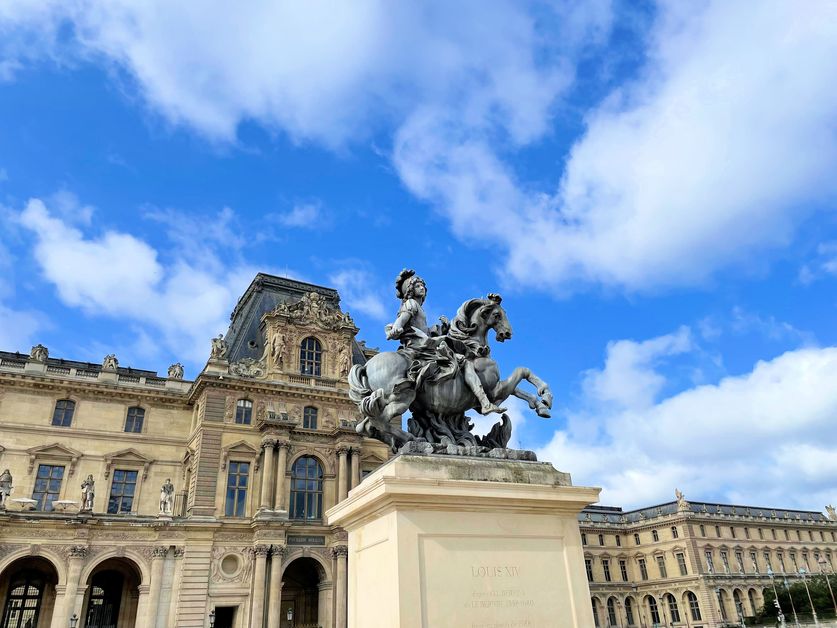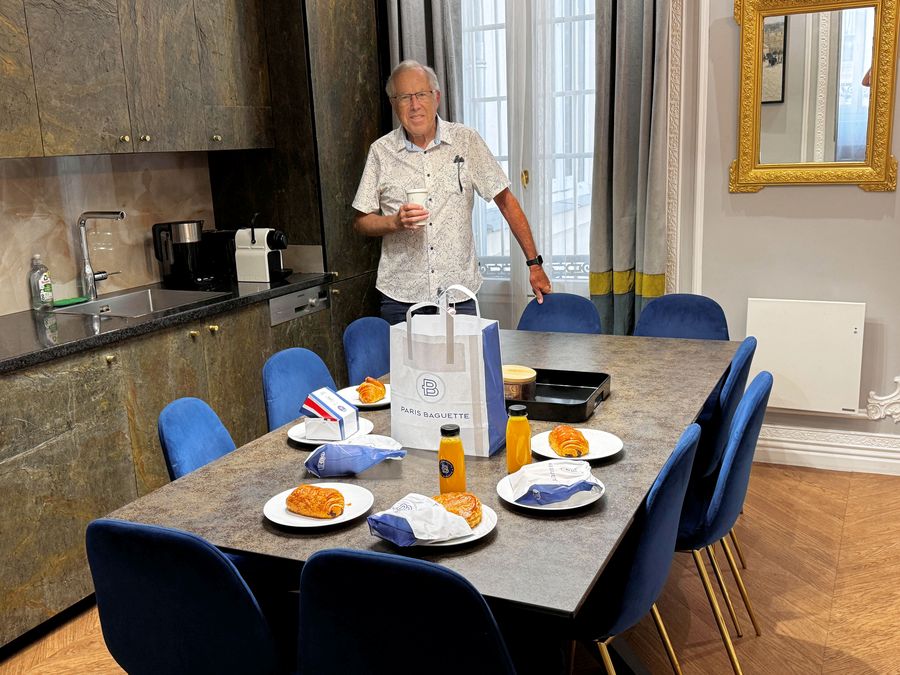THE WONDER OF THE LOUVRE MUSEUM

On our last day in Paris during our France trip this summer we joined our daughter Lisa’s family for a private tour of the Louvre. Marla and I have visited this amazing museum a number of times, but having a private guide opened our eyes like never before! I’ll share images of our tour. The imposing equestrian sculpture of Louis XIV has a fascinating history. Click on the hypertext link.

The entrance was surprisingly empty for a July morning. We had to show proof of vaccination. As of August 10, “In accordance with government recommendations, all visitors to the Louvre aged 18 and over must show a Health Pass. From 30 September, this obligation will apply to all visitors aged 12 and over.”

Our guide is originally from Brazil but lives in Paris and is a student of art history.

The iconic glass pyramids, designed by Chinese-American architect I.M. Pei, were completed in 1988. Some critics initially said it was “sacrilegious” to tamper with history when the project was announced.

I love the undulating staircase under the glass pyramids.

Our guide introduced us to the medieval part of the “Sully” wing, the oldest part of the Louvre Museum.

The foundation walls next to the ancient moat opened to visitors after archeological excavations of the 1980’s.

The Giant Sphinx of Tanis from 2600 BC is one of the largest outside of Egypt.

The “Salle des Caryatides” in the Sully wing was begun by King Henri II and contains beautiful Greek and Roman sculptures. The “Borghese Centaur” is from Imperial Rome.

I was fascinated with “Silenus cradling the infant Dionysus.” A 2nd century Roman copy of the Greek original, the sculpture was purchased by Napoleon in 1807.

The name of the gallery comes from the 4 “Caryatids”, sculpted female figures shown above, supporting the musicians gallery. They were made by the sculptor, Jean Goujon in 1550.

Artemis with a doe, “Diane of Versailles”, is from 2nd century Imperial Rome.

The famous “Venus de Milo” is from the Hellenistic period in the 2nd century B.C.

The 18th century sculpture of the famous lovers by Antonio Canova, “Psyche Revived by Cupid’s Kiss”, is simply mesmerizing!

As we climbed the stairs the imposing sculpture of the “Winged Victory of Samothrace“, or the Nike of Samonthrace”, loomed above in all its power and grandeur.

This is one of the few original major Hellenistic sculptures in existence rather than Roman copies.

The crowds lining up in an orderly queue for the Mona Lisa remind me of TSA passenger screening at the airport. We walked on to observe other paintings.

I took this photo in 2009 and very little has changed,…except the color of the walls!

Eugene Delacroix’s “Liberty Leading The People”, commemorating the July Revolution of 1830 which toppled King Charles X of France, became his most famous work.

Theodore Gericault’s 1819 painting, “The Raft of Medusa”, depicts the aftermath of the 1816 wreck of the French Royal Navy frigate the Medusa, which ran aground off the coast of Senegal. Symbolizing the oppression inflicted on the weakest and the helpless in France during the “Bourbon restoration” after Napoleon’s defeat in 1815, the painting was thought to be too political and gruesomely realistic by some critics of the time.

Gericault’s gigantic, “The Charging Chasseur”, depicts an officer dressed in traditional military attire from the Napoleonic period of French history.

One of my favorite rooms is the “Galerie d’Apollon” first designed in the 1660’s. “Breathtaking” is the only word to describe it! King Louis XIV gathered the greatest artists, sculptors, and gilders of the day to work here. They later worked on the Chateau de Versailles. Ornate vitrines which line the center are filled with Royal Jewels and objects of beautiful historical significance.

The large painting in the center of this photo is Delacroix’s, “Apollo Slays The Dragon.” Other murals are by Le Brun and sculptures by Girardon.

Louis IV had an obsession with hardstone vessels, owning over 800 of them.

This magnificent crown was made for the coronation of King Louis XV in 1722.

This stunning tiara belonged to the Duchess d’Angouleme. It was a gift from the Duchess’ husband, Louis Antoine, the Duke of Angouleme. She was the only surviving child from the union of Marie- Antoinette and Louis XVI. It was made in 1819.

I’ve always loved clear rock crystal. These vessels are amazing!

The word “grand” does not do justice to the “Le Grand Salon” of the apartments of the Napoleon III in the Louvre.

The dining room is sensational in it’s opulence.

I think Marla and I both said….”Wow.”
I hope you enjoyed this little tour of one of the world’s most treasured museums!
Photos: Dick Gentry. Not to be used without permission!
About The Author
admin
Related Posts
AUDREY HEPBURN ONCE SAID…“PARIS IS ALWAYS A GOOD IDEA.” I COULDN’T AGREE MORE!
Paris has always held a special place in Marla’s and my heart. Even…
September 17, 2021PARIS 2024 OLYMPICS…”CITIUS, ALTIUS, FORTIUS”
It was all about “FASTER, HIGHER, & STRONGER” as we spent a week…
September 17, 2021

Ed parent | 17th Sep 21
Dick. Absolutely loved the photos. The crystal , crowns, and sculptures are magnificent. I have only spent one hour at the Louvre. Time crunch. I will go back and like you will get a guide. Love to Marla
admin | 22nd Sep 21
Hi Ed, I saw it with a brand new perspective!